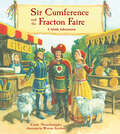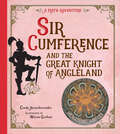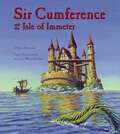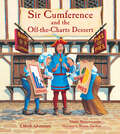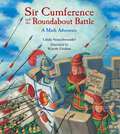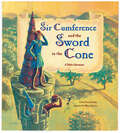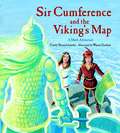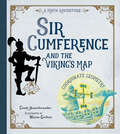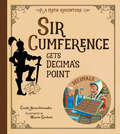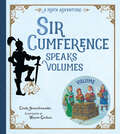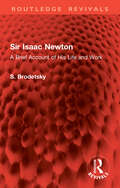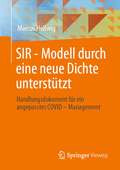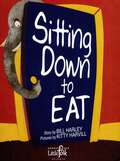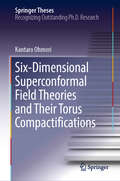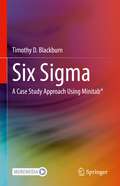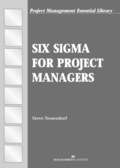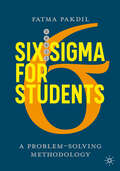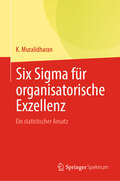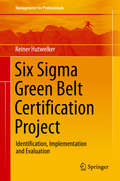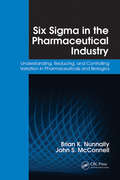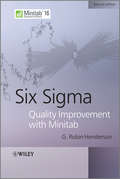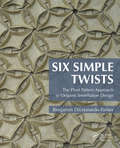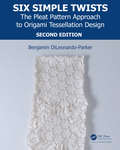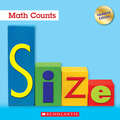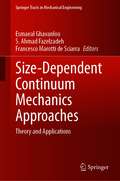- Table View
- List View
Sir Cumference and the Fracton Faire: A Math Adventure (Sir Cumference)
by Cindy NeuschwanderJoin Sir Cumference and the gang for more wordplay, puns, and problem solving in the clever math adventure that introduces readers to the concept of fractons. Sir Cumference and Lady Di discover "Fracton numbers" while purchasing cloth and cheese at the Fracton Faire. While two-fourths may seem like the same as one-half, in truth it denotes two parts of one-half, or two quarters of the whole. But the real mystery is the fact that items at the fair keep disappearing, and Sir C, Lady Di, and the Earl of Fracton must set a numeric trap for the thief, teaching an important lesson along the way about the comparative size of fractions. Puns--both literal and visual--abound in this fun adventure story with beloved characters and a solid pedagogical foundation. A fun little math adventure that introduces the basics of fractions to early elementary audiences.— School Library Journal
Sir Cumference and the Great Knight of Angleland (Sir Cumference)
by Cindy NeuschwanderJoin Sir Cumference, Lady Di of Ameter, and their son Radius for wordplay, puns, and problem solving in this angle-packed math adventure. In the third installment of the beloved Sir Cumference series, Radius must prove himself on his quest for knighthood by rescuing a king. Sent off with the family medallion for luck, Radius dodges dangers and dragons. The ultimate challenge lies in a mysterious castle with a maze of many angles.
Sir Cumference and the Isle of Immeter (Sir Cumference)
by Cindy NeuschwanderJoin Sir Cumference and the gang for more wordplay, puns, and problem solving in the clever math adventure that introduces readers to the concepts of area and perimeters. When young Per visits her uncle Sir Cumference and his family, she learns how to play the game, "Inners and Edges." After she finds a clue linking the game to the mysterious castle on the island of Immeter, she must figure out how to find the perimeter and area of a circle to unlock the island's secret. Fans will love cracking the code with Per and the gang in this new installment of the Sir Cumference series that makes math fun and accessible for all.
Sir Cumference and the Off-the-Charts Dessert (Sir Cumference)
by Cindy NeuschwanderJoin Sir Cumference and the gang for more wordplay, puns, and problem solving in the clever math adventure that introduces readers to charts and graphs through an annual bake-off. Sir Cumference and Lady Di need a baker to prepare a special dessert for the annual Harvest Faire. Two bakers compete to see whose dessert is most popular. When Pia of Chartres and Bart Graf have trouble keeping track of the votes their desserts receive, they each develop a better system. Pia places a colored candy around the edges of a pie dough (like a pie chart), and Bart stacks up cookie tins (making a 3D bar graph). When there's a tie, the two chefs cook up a hybrid dessert just in time for the Faire. Puns--both literal and visual--abound in this fun adventure story with beloved characters and a solid pedagogical foundation.
Sir Cumference and the Roundabout Battle (Sir Cumference)
by Cindy NeuschwanderJoin Sir Cumference and the gang for more wordplay, puns, and problem solving in the clever math adventure that introduces readers to the concept of rounding numbers. When Steward Edmund Rounds and Sir Cumference notice that there are strangers camped nearby, Rounds II decides to investigate despite being involved with the task of learning how to make accurate counts of the castle's stores of food, supplies, and weaponry. When he reports back that an enemy is lying in wait, everyone moves quickly to defend the castle. But wait! Will Rounds II be able to figure out how many bows and arrows they have to create an appropriate battle plan? Using rounding techniques to figure out the totals more quickly, Rounds II is just in time to help stave off a potentially disastrous attack. Readers will love making the rounds with Rounds II and the gang in this new installment of the Sir Cumference series that makes math fun and accessible for all.
Sir Cumference and the Sword in the Cone (Sir Cumference)
by Cindy NeuschwanderA funny and pun-filled retelling of &“The Sword and Stone&” that introduces readers to mathematical angles. King Arthur has hidden his sword, Edgecalibur and issued a challenge to the knights. The first knight to find the sword will be the next king. Can Sir Cumference and Lady Di point Radius's best friend, Vertex in the right direction? Will Vertex's sharp thinking give him the edge?Join Sir Cumference, Lady Di of Ameter, and their son, Radius, in this new adventure where they race to help Vertex find the sword and discover the secrets of cubes, pyramids, cylinders, and cones.
Sir Cumference and the Viking Map (Sir Cumference Ser.)
by Cindy NeuschwanderFor fans of the Sir Cumference series with coordinate geometry on their mind, here is the seventh installment in this fun look at math and language. <P><P>While riding through the forests of Angleland, cousins Per and Radius realize they are lost and are desperate for a map to guide them home. Soon they come across a mysterious house in the hills. Inside they find a map to a treasure belonging to Xaxon Yellowbearyd, the fiercest Viking warrior of his time. Per and Radius must decode the strange numbered grid on the map, while trying to steer clear of the pack of bungling bandits who are on their tail. Will they find the treasure in time? <P><P>Cindy Neuschwander delivers yet another intriguing math adventure featuring the well-known characters of Angleland. Readers will enjoy following Per and Radius in their quest while learning how coordinate geometry relates to everyday life. Wayne Geehan’s beautiful illustrations offer a bit of comic relief, while also clearly demonstrating the concepts explored in the story.
Sir Cumference and the Viking's Map (Sir Cumference)
by Cindy NeuschwanderFor fans of the Sir Cumference series with coordinate geometry on their mind, here is the seventh installment in this fun look at math and language. While riding through the forests of Angleland, cousins Per and Radius realize they are lost and are desperate for a map to guide them home. Soon they come across a mysterious house in the hills. Inside they find a map to a treasure belonging to Xaxon Yellowbearyd, the fiercest Viking warrior of his time. Per and Radius must decode the strange numbered grid on the map, while trying to steer clear of the pack of bungling bandits who are on their tail. Will they find the treasure in time?Cindy Neuschwander delivers yet another intriguing math adventure featuring the well-known characters of Angleland. Readers will enjoy following Per and Radius in their quest while learning how coordinate geometry relates to everyday life. Wayne Geehan&’s beautiful illustrations offer a bit of comic relief, while also clearly demonstrating the concepts explored in the story.
Sir Cumference Gets Decima's Point (Sir Cumference)
by Cindy NeuschwanderPart of the popular Sir Cumference series! Baker Pia is back with a handy way of counting by tens and fractions in this fun introduction to the decimal system.This time the focus is back on Pia of Chartres from Sir Cumference and the Off-the-Charts Dessert. She is kidnapped by a family of ogres--Tentt, the father, Hoondrit, the mother, and their ten daughters, Una to Decima. Pia is asked to help the ogres prepare a feast for a large celebration, which will involve tens, hundreds, even thousands of pieces of dessert! Readers will learn about place value and the decimal system of notation in this latest medieval math adventure. The endnote includes a diagram with place names.
Sir Cumference Speaks Volumes (Sir Cumference)
by Cindy NeuschwanderMedieval math favorites Sir Cumference and Lady Di of Ameter learn a method to calculate volume in this adventure story introduction to a math curriculum staple.While on horseback, Sir Cumference hears news about an impending snow siege from a young countryman named Volomo Longitudo Latitudo Altitudo. Volomo invites Sir Cumference in and shows him a nifty method for storing grains so that the harvest is easily countable and stackable. At the castle, Sir Cumference and Lady Di open their doors for people to seek shelter during the blizzard. But when they run out of food, Sir Cumference and Lady Di must use Volomo's method to measure how much grain they need to feed everyone.This thirteenth book in the Sir Cumference series teaches solid math skills with clever problem-solving.
Sir Isaac Newton: A Brief Account of His Life and Work (Routledge Revivals)
by S. BrodetskyOriginally published in 1927 this book presents the main features of Newton’s life and his chief contributions to scientific knowledge. It gives the non-scientist, as well as the specialist, an insight into the life, personality and achievements of one of England’s greatest scientists and polymaths.
SIR - Modell durch eine neue Dichte unterstützt: Handlungsdokument für ein angepasstes COVID – Management
by Marcus HellwigDas durch eine neue Dichte unterstützte SIR – Modell und dessen Derivate erhalten einen statistischen Datenhintergrund aus Häufigkeitsverteilungen, aus deren Parameterwerten über die neue Dichteverteilung auf eine qualitätsorientierte Wahrscheinlichkeit des jeweiligen Infektionsprozesses und seiner Zukunft geschlossen werden kann. Dadurch erhält das COVID - Management eine funktionsgemäße modellhafte Grundlage zur vorbeugenden Steuerung der Komponenten Zeitplanung, Kostenentwicklung, Qualitätsmanagement und Personal- und Materialeinsatz.
Sitting Down to Eat picture book
by Bill HarleyIn this cumulative story, a young boy agrees to share his snack with an ever-growing menagerie of animals, each insisting that there is room for one more.
Six-Dimensional Superconformal Field Theories and Their Torus Compactifications (Springer Theses)
by Kantaro OhmoriThis thesis describes the structures of six-dimensional (6d) superconformal field theories and its torus compactifications. The first half summarizes various aspects of 6d field theories, while the latter half investigates torus compactifications of these theories, and relates them to four-dimensional superconformal field theories in the class, called class S. It is known that compactifications of 6d conformal field theories with maximal supersymmetries provide numerous insights into four-dimensional superconformal field theories. This thesis generalizes the story to the theories with smaller supersymmetry, constructing those six-dimensional theories as brane configurations in the M-theory, and highlighting the importance of fractionalization of M5-branes. This result establishes new dualities between the theories with eight supercharges.
Six Sigma: A Case Study Approach Using Minitab®
by Timothy D. BlackburnThis book introduces the reader to Six Sigma, a problem-solving technique for reducing defects and variation in processes. The author uses DMAIC phases (Define, Measure, Analyze, Improve and Control) and a data-centric approach, leveraging applied statistics with Minitab®. Readers are enabled to solve novel problems where there isn’t an apparent root cause or solution identified. The author walks readers through an (imaginary) case study, explaining both the DMAIC approach and how to use Minitab in a practical way. The presentation includes data sets and instructions on how to analyze data in the context of Six Sigma using Minitab.
Six Sigma for Project Managers
by Steve NeuendorfSix Sigma is a collection of ideas and tools that many organizations are using as part of their efforts to improve the quality of their products and services. Six Sigma for Project Managers explores the concepts that project managers need to know to make six sigma work for their organizations.
Six Sigma for Students: A Problem-Solving Methodology
by Fatma PakdilThis textbook covers the fundamental mechanisms of the Six Sigma philosophy, while showing how this approach is used in solving problems that affect the variability and quality of processes and outcomes in business settings. Further, it teaches readers how to integrate a statistical perspective into problem solving and decision-making processes. Part I provides foundational background and introduces the Six Sigma methodology while Part II focuses on the details of DMAIC process and tools used in each phase of DMAIC. The student-centered approach based on learning objectives, solved examples, practice and discussion questions is ideal for those studying Six Sigma.
Six Sigma für organisatorische Exzellenz: Ein statistischer Ansatz
by K. MuralidharanIn diesem Buch werden die integrierten Konzepte des statistischen Qualitätsengineerings und der Managementinstrumente erörtert. Es hilft den Lesern, die Konzepte der Qualität durch Projektmanagement und technische Analyse unter Verwendung statistischer Methoden zu verstehen und anzuwenden. Der Text ist so aufbereitet, dass er Praktiker in die Lage versetzt, die Six-Sigma-Prinzipien in Projekten umzusetzen. Die erörterten Konzepte werden alle kritisch bewertet und erläutert, so dass sie in der Praxis bei der Entscheidungsfindung des Managements angewendet werden können, und in jedem Kapitel werden die Ziele und Verbindungen zum Rest des Werks deutlich dargestellt.Um das Verständnis zu erleichtern, enthält das Buch eine Fülle von Tabellen, Grafiken, Beschreibungen und Checklisten sowie Diagramme und Darstellungen, ausgearbeitete Beispiele und Übungen. Das vielleicht einzigartigste Merkmal des Buches ist sein Ansatz, die Wissenschaft hinter dem Six Sigma-Projektmanagement mit Hilfe statistischer Werkzeuge zu erklären und in technische Konzepte zu integrieren. Das Material über Qualitätstechnik und statistische Managementwerkzeuge bietet wertvolle Unterstützung für Studenten, Doktoranden und Forscher. Das Buch kann auch als kompakter Leitfaden für Six Sigma-Profis, Green Belt-, Black Belt- und Master Black Belt-Ausbilder dienen.
Six Sigma Green Belt Certification Project: Identification, Implementation and Evaluation (Management for Professionals)
by Reiner HutwelkerThis book helps professionals to turn their own Six Sigma projects into reality. Using a sample project, the book guides readers through all aspects of Six Sigma, from identifying and defining a suitable project topic, to sustainably managing its success in the control phase. By demonstrating all the necessary steps supported by a DMAIC software guide, it makes the application of the sequentially linked DMAIC tools easy to understand and directly transferable to typical Six Sigma business projects. Further, each chapter provides numerous questions and answers, tasks and the framework for an environmental standard project. This book is an essential part of the author’s teaching material on the topic, which also includes the software ‘sigmaGuide’, a template for project documentation and several hours of video content featuring course materials on edX Learning Community.
Six Sigma in the Pharmaceutical Industry: Understanding, Reducing, and Controlling Variation in Pharmaceuticals and Biologics
by Brian K. Nunnally John S. McConnellSix Sigma in the Pharmaceutical Industry is the first book to introduce the fundamentals of Six Sigma, examine control chart theory and practice, and explain the concept of variation management and reduction applied specifically to the pharmaceutical industry. The first half lays out a conceptual framework for understanding variation, while the second half introduces control chart theory and practice. Using case studies and statistics, the book illustrates the concepts and explains their application to actual workplace improvements. Providing the basis for a complete operating philosophy, this book focuses on core concepts and their implementation to improve the existing products and processes in the pharmaceutical industry.
Six Sigma Quality Improvement with Minitab
by G. Robin HendersonThis book aims to enable readers to understand and implement, via the widely used statistical software package Minitab (Release 16), statistical methods fundamental to the Six Sigma approach to the continuous improvement of products, processes and services.The second edition includes the following new material:Pareto charts and Cause-and-Effect diagramsTime-weighted control charts cumulative sum (CUSUM) and exponentially weighted moving average (EWMA)Multivariate control chartsAcceptance sampling by attributes and variables (not provided in Release 14)Tests of association using the chi-square distributionLogistic regressionTaguchi experimental designs
Six Simple Twists: The Pleat Pattern Approach to Origami Tessellation Design
by Benjamin DiLeonardo-ParkerGet Started with Tessellation FoldingSix Simple Twists: The Pleat Pattern Approach to Origami Tessellation Design explains the process of designing an origami pattern. It answers the questions "how is a tessellation folded" and "what are the further possibilities."The author introduces an innovative pleat pattern technique of origami design that is
Six Simple Twists: The Pleat Pattern Approach to Origami Tessellation Design (AK Peters/CRC Recreational Mathematics Series)
by Benjamin DiLeonardo-ParkerThis new edition of Six Simple Twists: The Pleat Pattern Approach to Origami Tessellation Design introduces an innovative pleat pattern technique for origami designs that is easily accessible to anyone who enjoys the geometry of paper. The book begins with six basic forms meant to ease the reader into the style, and then systematically scaffolds the instructions to build a strong understanding of the techniques, leading to instructions on a limitless number of patterns. It then describes a process of designing additional building blocks. At the end, what emerges is a fascinating artform that will enrich folders for many years. Unlike standard, project-based origami books, Six Simple Twists focuses on how to design, rather than construct. In this thoroughly updated second edition, the book explores new techniques and example tessellations, with full-page images, and mathematical analysis of the patterns. A reader will, through practice, gain the ability to create still more complex and fascinating designs. Key Features Introduces the reader to origami tessellations and demonstrates their place in the origami community New layout and instructional approach restructure the book from the ground up Addresses common tessellation questions, such as what types of paper are best to use, and how this artform rose in popularity Teaches the reader how to grid a sheet of paper and the importance of the pre-creases Gives the reader the ability to create and understand tessellations through scaffolded instruction Includes exercises to test understanding Introduces a new notation system for precisely describing pleat intersections Analyzes pleat intersections mathematically using geometrically-focused models, including information about Brocard points
Size (Math Counts: Updated Editions)
by Henry PluckroseAn introduction to capacity for the youngest readers!Math Counts series introduces young readers (grades K-3) to early math concepts. Real-world examples and corresponding photos make math concepts easy to grasp.We use the words big and small to describe the size of things. They help us compare things.
Size-Dependent Continuum Mechanics Approaches: Theory and Applications (Springer Tracts in Mechanical Engineering)
by Esmaeal Ghavanloo S. Ahmad Fazelzadeh Francesco Marotti de SciarraThis book offers a comprehensive and timely report of size-dependent continuum mechanics approaches. Written by scientists with worldwide reputation and established expertise, it covers the most recent findings, advanced theoretical developments and computational techniques, as well as a range of applications, in the field of nonlocal continuum mechanics. Chapters are concerned with lattice-based nonlocal models, Eringen’s nonlocal models, gradient theories of elasticity, strain- and stress-driven nonlocal models, and peridynamic theory, among other topics. This book provides researchers and practitioners with extensive and specialized information on cutting-edge theories and methods, innovative solutions to current problems and a timely insight into the behavior of some advanced materials and structures. It also offers a useful reference guide to senior undergraduate and graduate students in mechanical engineering, materials science, and applied physics.
